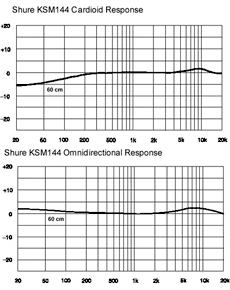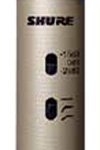The Shure KSM141
dual pattern condenser instrument microphone is a chameleon: part
rugged road-worthy and dependable workhorse and part delicate studio
microphone capable of meeting the highest audiophile standards.
I received a stereo matched pair of champagne-finished KSM141's
in the A141SPC carrying case with a pair of A100WS windscreens and
A57C stand mounts.
The KSM141 is an end-addressed electret (permanently self-biased)
condenser microphone with dual polar patterns, cardioid and omnidirectional,
switched mechanically by rotating a collet just below the capsule.
Mechanical polar pattern switching is said to produce highly consistent
cardioid and true omnidirectional pickup patterns. This works by
blocking the rear ports (and rear entering sound waves) behind the
capsule preventing cardioid operation. There is a hard detent that
locks at either pattern position. You cannot "blend" between
one pattern and the other; the manual warns of unpredictable operation
if you try this. Muting the mic's output when changing patterns
is a must: I can confirm that you will test your loudspeaker's cone
excursion limit if the mic is hot and you change patterns!
The capsule's diaphragm is 24-karat gold-layered Mylar just 2.5
microns thick. A Class-A discrete, transformerless preamplifier
is used and all internal and external connectors are gold-plated.
There is a built-in subsonic filter to reduce mechanical vibrations
(lower than 17 Hz) that usually travel up mic stands, particularly
on live stages.
One unique feature for a pencil mic is a three-position switchable
attenuator pad with 0dB, 15dB, and 25dB positions. The KSM141 puts
out a hot level and handles extremely high sound pressure levels
(SPLs). With the –25dB attenuator switched in, the mic will
take 164dB SPL and put out +15dBv signal into a 5kohm impedance.
For the sake of your microphone preamp, you must use the –15dB
or –25dB position when close miking loud instruments like
snare drums or electric guitar cabs. Otherwise for quiet acoustic
instruments, no pad and the mic's 14dB self-noise work great.
Another
top-notch feature is the three-position low frequency roll-off switch.
Settings are flat; 18 dB per octave at 80 Hz; and 6 dB per octave
at 115 Hz. These filter specs are exactly like the Shure KSM44 multi-pattern
studio condenser.
I found a big difference in sound quality between cardioid and
omnidirectional patterns and the frequency response charts below
confirm this. (See The Graph Below) In cardioid, the sound is very
focused and forward in nature. There is an inherent bass roll-off
that sounds like what I'd do with an equalizer to lose the effects
of proximity when close-miking instruments. Most of the time, you'll
find no need to roll off bass when the 141 is within six inches
of an acoustic guitar or bass drum.
 In omnidirectional pattern, the mic's sound is totally different.
The low end comes up and the top opens up in a smooth, faithful
way. I also had more level in omni and
I preferred the mic in this pattern for use in the recording
studio. I especially liked omni for acoustic guitar, drum
overheads, and room miking.
In omnidirectional pattern, the mic's sound is totally different.
The low end comes up and the top opens up in a smooth, faithful
way. I also had more level in omni and
I preferred the mic in this pattern for use in the recording
studio. I especially liked omni for acoustic guitar, drum
overheads, and room miking.
I tried the mic in three different studios: LAFX Studio with
its API console, Jay Graydon's private use studio with a Neve
VR, and Oliver Leiber's studio with a rack Neve 1084 modules.
 On acoustic guitar I compared the KSM141 set to cardioid to
AKG's C-451B (another electret) and Neumann's KM184.
On acoustic guitar I compared the KSM141 set to cardioid to
AKG's C-451B (another electret) and Neumann's KM184.
No doubt about it, all three mics sound great but the Neumann
had more subsonic frequencies I would have to roll-off and the C-451B
required a shot of mid-range EQ to bring the guitar forward in my
mix. In a word, the KSM141 had the sound I was looking for…"dialed
in" right out of the box! I also compared the KSM to an older
C-451E and found similar results.
I set the mics to omni for drum overheads and compared them to Swedish
Milab DC 96B cardioid condensers… a mic that costs about twice
as much as the KSM141. I was about 18 inches above the highest cymbals
and used no attenuator pads. (The Milabs have none). My results
were too close to call. The Milabs did require 5dB more gain out
of the Neves to get the same levels and, because the KSM’s
were in omni, they covered the kit better.
Whether you are mixing live sound one day and recording the next,
the KSM141 will not let you down with their clear sound and dependable
operation. They are ruggedly made and fit into any mic collection
right along side your dynamic mics. The Shure KSM141/SL sells for
$770MSRP and the matched stereo pair is $1,540MSRP. For more specific info on the KSM141, go to:
www.shure.com/microphones/models/ksm141.asp